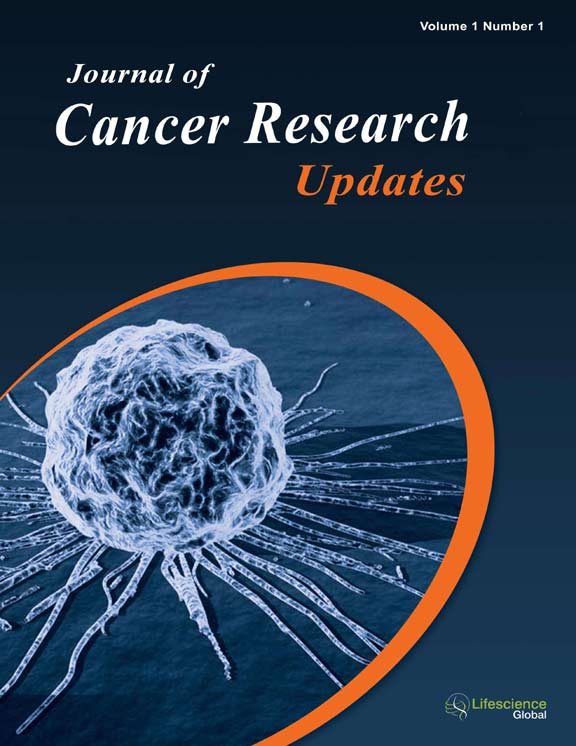jcru
|
|
Abstract: Background: Endometrial cancer is one of the most common gynecology malignancies. But there is still lack of an accurate, reliable, convenient, easy, economical and practical method for early detection of endometrial cancer and precancerous lesions. The aim of this study is to evaluate the specimen quality and diagnostic accuracy of endometrial cytology examination in the screening of endometrial cancer. Methods: 95 patients with abnormal uterine bleeding or vaginal ultrasound examination results indicating intrauterine abnormalities and needing endometrial examination were investigated, and specimens were collected using endometrial sampling device for cytology (ESDC) and sliced using thinprep cytology test (TCT), meanwhile, hysteroscopy auxiliary diagnostic curettage and histopathological examination were performed. Results: The satisfaction rate was 100% for the specimens collected using ESDC and 97.9% for those using diagnostic curettage. The difference in the satisfaction rate of collecting specimens was statistically significant between the two methods, and the satisfaction rate of collecting specimen using endometrial cytology was superior to that using diagnostic curettage. Taking diagnostic curettage histopathologic results as "gold standard", the sensitivity of endometrial cytology was 63.6%, specificity 93.6%, positive predictive value 70% and negative predictive value 95.2% in the screening of endometrial cancer. Conclusion: Endometrial cytology can be used as a reliable, safe and simple method in the screening of endometrial cancer. Keywords: Endometrial cytology, endometrial sampling device for cytology, endometrial cancer, thinprep cytology test. Download Full Article |
|
|
Abstract: We present herein a case of a 24-year-old woman with incidentally diagnosed right adrenal ganglioneuroma with 14cm in size that was removed completely by the laparoscopic approach. The patient was asymptomatic and the tumor was first diagnosed on abdominal ultrasonography. A subsequent computed tomography (CT) of the abdomen confirmed a 12x 11x9cm complex expansive mass of right adrenal, with well-defined outlines. Magnetic resonance imaging (MRI) showed a solid lesion measuring 11 x 9 x 11cm arising from the right adrenal. Laparoscopic complete excision of the mass was accomplished through a transabdominal lateral approach. The surgical specimen weighed 665 g and 14 x 10 x 7 cm in size. There was no complication in postoperative period, and the patient was released from the hospital two days after the operation. The patient resumed her normal activities in one week. Histology was consistent with an adrenal ganglioneuroma. A control CT was made one year after the surgery with no evidence of lesion suggestive of relapse. Adrenal ganglioneuromas are rare lesions with a benign behavior in which surgery is the only possible form of treatment. In centers of advanced laparoscopy this method of access can be used, even for larger lesions. Keywords: Urology, Oncological Surgery, general laparoscopy. Download Full Article |
|
|
Abstract: Metastases are the major culprits behind most cancer-related death and the central challenge to the eradication of a malignancy. Circulating tumor cells (CTCs) have the potential to help us understand how metastases form, to be utilized for cancer diagnosis and treatment selection and even to be targeted for cancer treatment. Many advances have been made regarding the isolation of these rare cells. However, several challenges and limitations in CTC analysis still exist. Multiple color immunofluorescence, genetic analysis (e.g. Fluorescence in situ Hybridization, microarray and next generation sequencing) and CTC culture will be effective tools to study CTCs and provide information on metastatic mechanism and clinical implication. In this review, we discuss the importance of CTC study in understanding cancer metastasis and their potential clinical application as biomarkers to predict cancer progression and treatment response, as well as the current situation for CTC isolation and analysis. Keywords: Circulating tumor cells, metastases, genetic alterations, biomarkers, prognosis, treatment response.Download Full Article |
|
|
Abstract: Autophagy is an evolutionarily conserved intracellular self-digestion process, which mediates homeostasis in response to various stresses via degradation of damaged organelles or unnecessary proteins. It has been demonstrated that autophagy involves in tumorigenesis and progression. Autophagy serves either as tumor suppressor or promotor in a context-dependent way. It has been revealed in multiple studies that autophagy plays a pro-survival role upon treatment of anticancer drugs. Thus, combination of autophagy inhibitors with anticancer drugs may provide a desirable strategy to improve therapeutic efficacy. In this review, we summarize recent progress in the process and regulation of autophagy with a highlight in advances in the role of autophagy in cancer treatment. We also summarize some recent clinical outcomes of combinatorial use of autophagy inhibitors and anticancer drugs, and introduce latest discovered selective autophagy inhibitors. Some issues which should be paid attention to during the research to improve the clinical outcomes are discussed. Keywords: Autophagy, cancer therapy, chloroquine, selective inhibitor.Download Full Article |
|
|
Abstract: Carcinoma of the breast is a leading cause of cancer deaths among women world-wide. Obesity is recognized as a well-established risk factor for epithelial tumors including the mammary epithelium. Adipose tissue is considered to be metabolically active organ with the ability to secrete a wide range of biologically active adipokines. Multiple studies have evaluated the potential mechanisms correlating obesity to increased risk of breast cancer. Altered circulating levels of adipokines or changed adipokine signaling pathways are now increasingly recognized to be associated with breast cancer development and progression. Leptin and adiponectin were the main adipokines that have been investigated in the context of breast cancer in both preclinical and epidemiological studies. Obesity is also believed to promote inflammatory response and induce activity of key enzymes like aromatase, leading to higher risk of breast cancer development. The goal of this review is to provide recent insights into the potential molecular mechanisms linking adipokines to the etiopathogenesis of breast cancer including recently identified adipokines and trying to correlate these molecular mechanisms to more established metabolic and hormonal dysregulations of obesity. A better understanding of the interplay between adipokines and other deregulated mechanisms in obesity is important for the development of preventive strategies with therapeutic potential against breast cancer in obese patients. Keywords: Adipokines, Obesity, Leptin, Adiponectin, Visfatin, Inflammation.Download Full Article |


